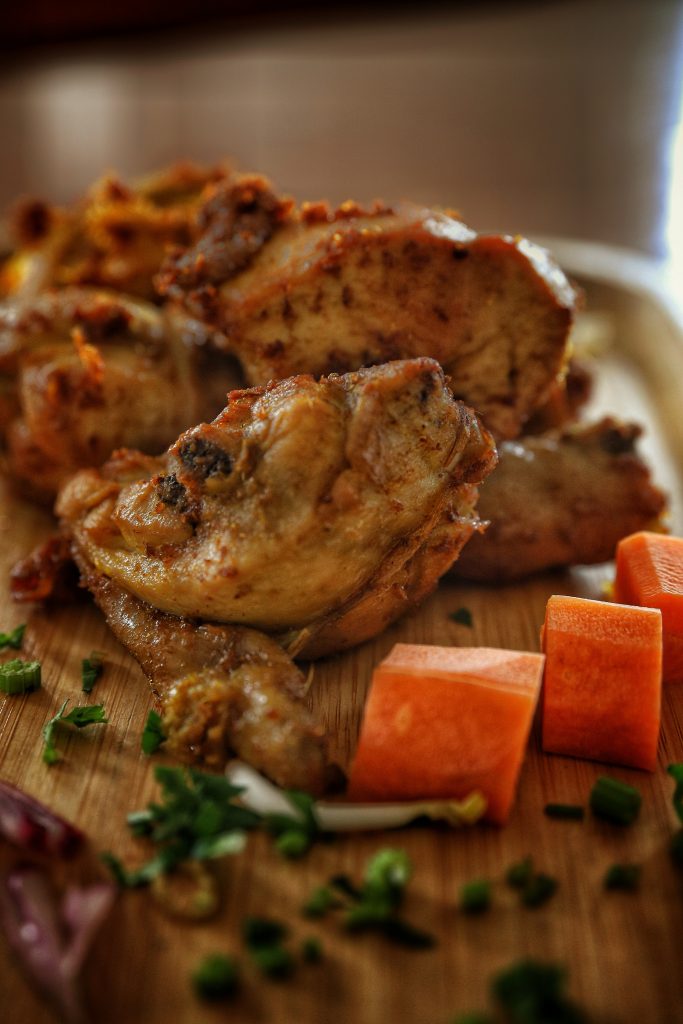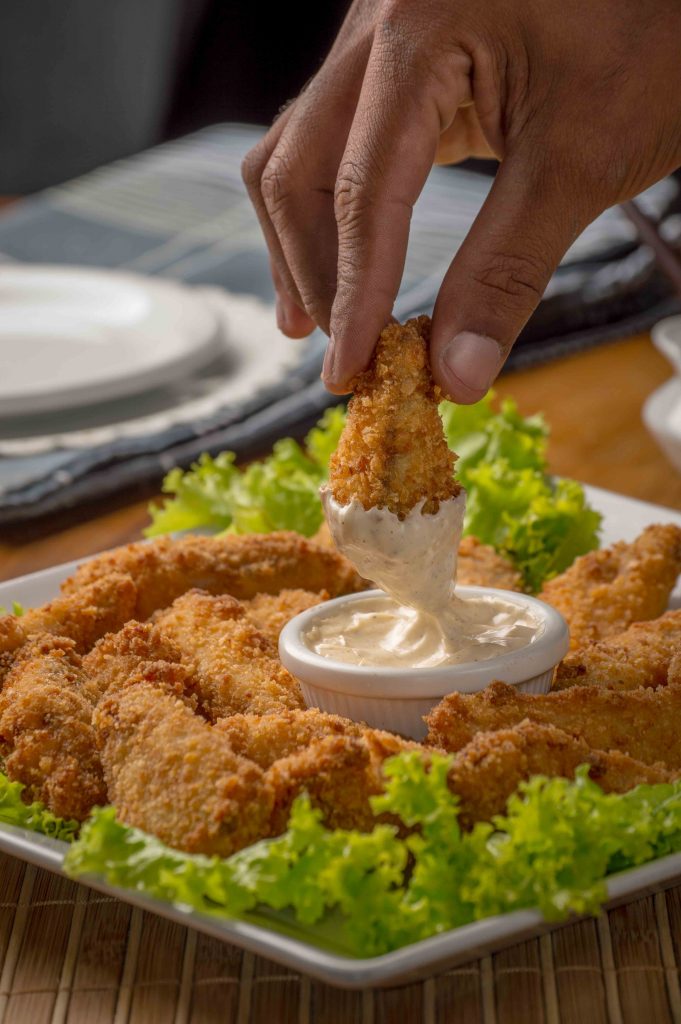As an Amazon Associate we earn from qualifying purchases.
Chicken thighs are a great source of nutrients such as zinc, iron, and protein. People love to combine nutrition along with good taste. Therefore, fried boneless chicken thighs are an excellent option to indulge in and a great start to know how to fry boneless skinless chicken thighs.
How to Fry Boneless Skinless Chicken Thighs?
Fried & boneless chicken thighs are juicy and irresistible. Making them skinless will help you cut down on extra calories and fats as if you fry with the skin.
It just absorbs much more oil. So, if you love fried chicken thighs, this guide can help you learn how to fry boneless skinless chicken thighs perfectly.
Method 1: Deep Frying Boneless Skinless Chicken Thighs
Deep frying is the easiest and most preferable method. It ensures evenly cooked chicken thighs. Deep frying above 325 Degrees Fahrenheit allows two flavoring processes to take place: caramelization and Maillard reaction.

These are the chemical secrets that make fried chicken so perfect and loved globally.
Step 1: Get the Ingredients for Deep Frying Chicken Thighs
- ½ cup of flour (All-purpose)
- Two teaspoons of salt
- black pepper, ½ teaspoon
- paprika, ½ teaspoon
- garlic powder, ½ teaspoon
- One cup of corn oil (or more as per need)
- Eight boneless and skinless chicken thighs
Note!
These ingredients are sufficient for cooking eight boneless skinless chicken thighs.
Step 2: Marinate the Chicken Thighs
- Combine flour, salt, pepper, garlic powder, and paprika in a large bowl.
- You can also use a resealable plastic bag for this purpose.
- Afterwards, pat and dry the chicken thighs with the use of paper towels
- Now, add them onto the flour mixture in a bowl or plastic bag.
- Coat and dredge the chicken thighs thoroughly with the flour mixture.
Step 3: Fry the Chicken Thighs
- Grab the best skillet for frying chicken and place it over the stove.
- Add oil to the skillet and turn on the stove to heat it.
- Let the oil heat up to 350 degrees Fahrenheit.
- Now, add chicken thighs to the skillet.
- Cover the skillet using one of your splatter guards.
- Let the chicken thighs cook while you turn their sides in intervals.
- Let them cook for around 20 minutes until you see a deep golden brown color.
- Arrange a plate with paper towels spread on it.
- Take out the chicken thighs and keep them on that plate to absorb the extra oil by the paper towels.
Deep frying may seem easy, but you have to take care of small details like oil temperature, seasonings, and marination time overs to get the process right. This video will help.
Method 2: Pan-Frying the Chicken Thighs
Pan-frying is yet another convenient method of cooking delicious boneless chicken thighs. You use a lot less oil, substantially reducing health and heart risks.
It is also favorable because it lets you prepare your dinner within 15 minutes. Hence, it is a faster as well as healthier alternative for frying boneless chicken thighs.

Step 1: Prep the Chicken Thighs
- Get a desirable amount of boneless chicken thighs.
- Make sure they are skinless.
- Place them on a big plate.
- Rub each of the chicken thighs with salt, pepper, and other seasonings.
- Sprinkle Garlic powder, chili powder, and onion powder (as per your need)
Step 2: Pan Fry the Chicken Thighs
- Take a non-stick frying pan and place it over the stove.
- Pour one tablespoon of cooking oil onto the pan.
- Turn on the stove at medium-high heat.
- Now, add the chicken thighs to the pan in a single layer.
- Make sure they are not touching one another.
- Let it cook without any disturbance for around 6 minutes.
- Use a spatula to flip the chicken pieces.
- Let the other side cook for another 6 minutes.
- Cut one chicken thigh while on the pan to check if the center is not pink anymore.
- If the center isn’t pink, it means that the chicken thighs are properly fried and ready.
Warning!
If you want your boneless and skinless chicken thighs to have a fantastic outer crust, then do not stir them or flip them again and again unnecessarily. It would be best if you flipped the chicken thighs only once.
Which Type of Pan Should You Use?
One option to cook pan-fried chicken thighs is using a cast-iron skillet. This type of pan is well-seasoned and will produce a crispy exterior and tender interior.
Additionally, rather than a stainless steel skillet, using cast iron with its heavy bottom ensures the fried chicken thighs will not stick to the pan, making them easier to flip.

Can You Crisp Chicken Thighs Without the Skin?
Crispy fried chicken without the skin? It’s possible! You can enjoy delicious, golden-brown pan-fried boneless skinless chicken thighs with a hot pan and a little patience.
Heat the pan before adding the olive oil and chicken, and wait for the outside to brown before flipping. This will help ensure the pieces don’t stick to the pan. You don’t need a skin for a tasty, crispy texture – just a hot pan and patience.
Do You Need to Bake the Chicken Thighs?
Cooking these pan-fried boneless chicken thighs need not require a baking process. A sizzling hot cast iron skillet and a few glugs of olive oil will give your food a delicious and crispy texture. This recipe is a great pick for a simple yet flavor filled oven-cooked option!
What to Serve With Fried Chicken Thighs
Deep or pan-fried boneless chicken thighs are a classic side dish usually served with other side dishes.
Some popular side dishes include garlic mashed potatoes, green beans, corn on the cob, fluffy cheesy biscuits, and delicious cornbread. For a more creative meal, pan fried boneless chicken thighs also pair nicely with roasted vegetables, pasta salad, fresh fruit, and seasoned rice.
How to Store Fried Chicken Thighs
You can store the boneless chicken thighs in the fridge for four days. To store the meat, put them in an airtight container or wrap it securely with aluminum foil.
To warm up, place the pieces on a baking sheet in a heated oven at 350 Degrees Fahrenheit for 10-15 minutes. Ensure that the warm oven has an internal temperature is 165 Degrees Fahrenheit.
Frequently Asked Questions
What Is the Cooking Time Difference Between Bone-in and Boneless Chicken Thighs?
The bone-in chicken thighs take around 25 to 30 minutes for cooking, whereas boneless chicken thighs take only 14 to 15 minutes.
You can use the food thermometer to check the internal temperature of the chicken thigh to know whether it is cooked or not. The temperature should be 165 degrees Fahrenheit.
How Many Calories Do We Intake by Eating Fried Chicken Thighs?
A 100 gram of fried chicken thighs will provide around 209 calories and 26 grams of protein. However, there are 0 carbs in it, and furthermore, it provides 10.9 grams of fat. Here are more facts on the nutritional details of chicken thighs.
Can I Bake Instead of Frying Chicken Thighs?
Yes, you can definitely bake your boneless and skinless chicken thighs. However, baking needs a bit more time than frying.
Hence, it is entirely upon you to choose the method that seems more convenient. If you want to bake your chicken thighs, then here is the recipe for the same.
Conclusion
Depending upon your choice, choose either pan fry or a deep-fry cooking process. The taste of chicken differs in both methods. There is always an option to bake since it opens another opportunity to try other recipes such as, baked chicken breasts.
So, it is highly recommended to try out both of them and opt more for the healthier pan-fried version. Make, relish and cherish your fried chicken thighs!
